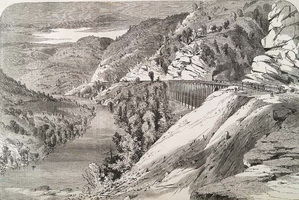 | Back to e-WV
| Back to e-WV
 The West Virginia Encyclopedia
The West Virginia Encyclopedia
 | Back to e-WV
| Back to e-WV
 The West Virginia Encyclopedia
The West Virginia Encyclopedia

The Tray Run Viaduct, located in Preston County north of Rowlesburg, was one of the most impressive early-19th-century railroad bridges in the nation and among the first modern iron railroad bridges in the United States. The original viaduct, an elevated railway consisting of a series of spans supported on arches, was constructed in the 1850s by the Baltimore & Ohio Railroad to permit passage across the Cheat River.
Building the viaduct and the tunnels and bridges on this section of railroad was a monumental undertaking given the topography of the region, and the project was unprecedented for its time. Originally designed for a single track, the curved viaduct had viewing platforms on each side for passengers and was admired as much for its graceful form and beauty as it was respected as an engineering marvel. During the Civil War Confederate raiders and saboteurs made several attempts, including the Jones-Imboden Raid of 1863, to destroy the Tray Run Viaduct, but their efforts failed to cause any damage. The durable viaduct became a source of state pride, and the state legislature placed an image of the structure on the reverse side of the West Virginia state seal. The original stone and cast-iron structure has been replaced by two succeeding viaducts, one in 1887 and the most recent 58-foot-tall structure in 1907.
Written by Barry Mowell
Plowden, David. Bridges: Spans of North America. New York: W. W. Norton & Co., 2001.
Wiley, S. & A. Frederick. A History of Preston County. Baltimore: Genealogy Warehouse, 1998.